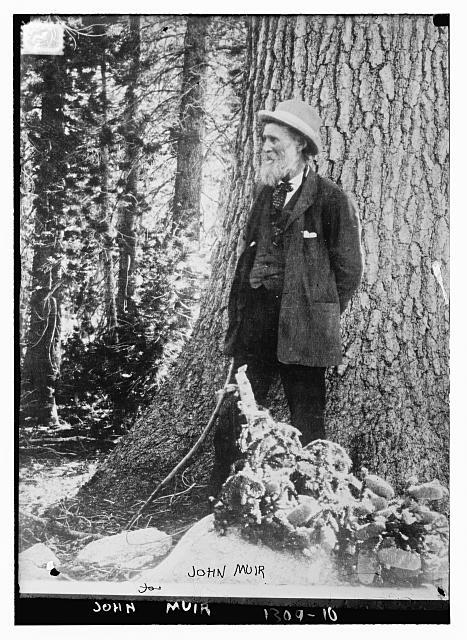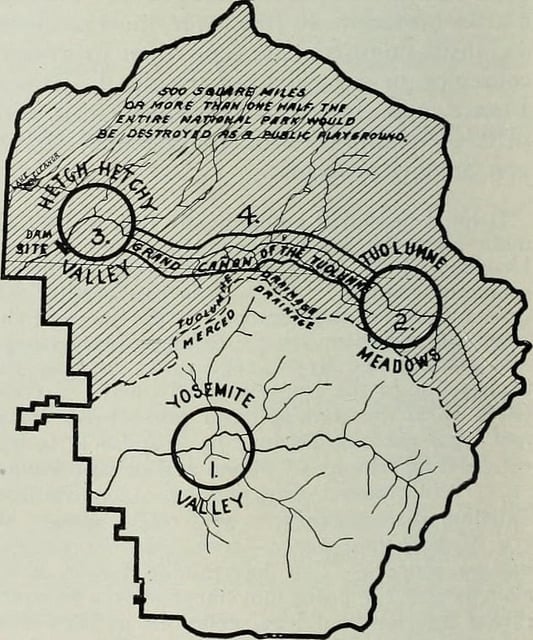
A Historical Assessment Lesson by Erik Nelson
Adapted from SHEG’s Beyond the Bubble assessments site.
Historical Content: Hetch Hetchy Dam Controversy: 1908-1914
Historical Skills: Corroboration, Sourcing

Intended Grades: 9-12
Directions: Use the excerpt to answer the questions that follow.
Source Background: In 1906 a massive earthquake and subsequent fires devastated the city of San Francisco. Debate arose between political and business leaders who called for a dam to be built to supply water to the city and the environmental advocates. In his book The Yosemite (1912), John Muir joined the debate.
Source Text: “These temple destroyers, devotees of ravaging commercialism, seem to have a perfect contempt for Nature, and, instead of lifting their eyes to the God of the mountains, lift them to the Almighty Dollar. Dam Hetch Hetchy! As well dam for water-tanks the people’s cathedrals and churches, for no holier temple has ever been consecrated by the heart of man.”
Question 1: Explain why a historian might not believe that Muir’s view alone provides enough evidence to understand the debate surrounding the dam.
Question 2: Three documents are described below. Explain whether each document could be used to support John Muir’s view, or why the document could not be used to support his position.

- Testimony before the House Committee on Public Lands by former San Francisco Mayor James Phelan about the utilitarian needs of San Francisco’s citizens.
- A letter from Robert Underwood Johnson to the Chairman of the House Committee on the Public Lands explaining the need of the country “to uphold its best ideals and its truest welfare against shortsighted opportunism and purely commercial and local interests.”
- A letter from the San Francisco Fire Department Widows and Orphans and Mutual Aid Associations, Inc, asking for the right to use the much needed water that would be supplied by the dam.
About the Assessment: This assessment asks students to source and corroborate a document. Students evaluate an excerpt of a 1912 book arguing against damming the Hetch Hetchy Valley in the Sierra. Question 1 asks students to evaluate whether the excerpt provides enough evidence to draw conclusions about the dam debate as a whole. To answer this question, students must source the document to determine whether the account can be thought of as conclusive evidence. Question 2 asks students to evaluate whether additional documents could be used to corroborate the argument.
Source Credits:
John Muir. The Yosemite. From the Sierra Club Web archive. Link Here.
Phelan Testimony and Johnson Letter: From American Social History Production, Inc. Link Here.
San Francisco Fire Department Letter: From the US National Archives Online. Link Here.
Lesson Reflection: As an aspiring architect of social studies classes that engage students in activities to promote historical thinking, it is often hard to brainstorm lessons or activities that address specific ways of thinking as a historian. I relied heavily (entirely) on the model created by Stanford History Education Group to build this lesson. It was very helpful to reverse engineer their assessment model, and I am grateful for the horizons they have opened for me in terms of assessment possibilities. I am also grateful to my Ed. Methods classmates for their help in editing this lesson. Their guidance again helped me to see that my first draft in crafting questions for high school students is never fully comprehensible. Our group worked collaboratively through Google Slides to build these lessons, which was a first big step in content generation. I also realize that reading my questions aloud, and having them read back to me in person, helped me to consider this lesson from a potential student’s point of view. Heavy revision and redirection was needed for clarity.
